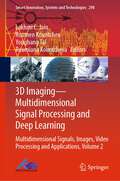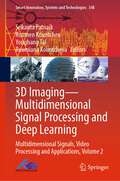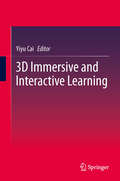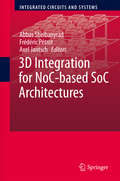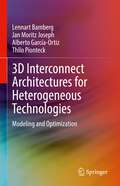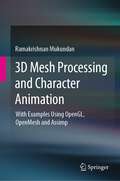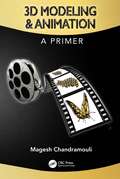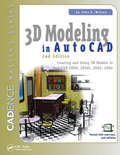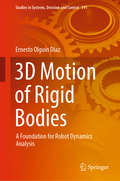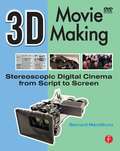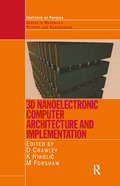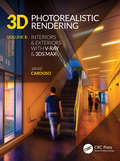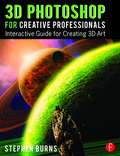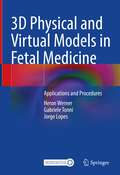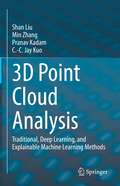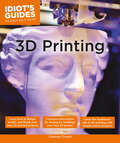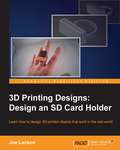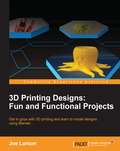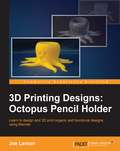- Table View
- List View
3D Imaging—Multidimensional Signal Processing and Deep Learning: Multidimensional Signals, Images, Video Processing and Applications, Volume 2 (Smart Innovation, Systems and Technologies #298)
by Lakhmi C. Jain Roumen Kountchev Yonghang Tai Roumiana KountchevaThis book gathers selected papers presented at the conference “Advances in 3D Image and Graphics Representation, Analysis, Computing and Information Technology,” one of the first initiatives devoted to the problems of 3D imaging in all contemporary scientific and application areas. The two volumes of the book cover wide area of the aspects of the contemporary multidimensional imaging and outline the related future trends from data acquisition to real-world applications based on new techniques and theoretical approaches. This volume contains papers aimed at the multidimensional systems and signal processing, deep learning, mathematical approaches and the related applications. The related topics are multidimensional multi-component image processing; multidimensional image representation and super-resolution; compression of multidimensional spatio-temporal images; multidimensional image transmission systems; multidimensional signal processing; prediction and filtering of multidimensional process; intelligent multi-spectral and hyper-spectral image processing, intelligent multi-view image processing, 3D deep learning, 3D GIS and graphic database; data-based MD image retrieval and knowledge data mining; watermarking, hiding and encryption of MD images; intelligent visualization of MD images; forensic analysis systems for M3D graphics algorithm; 3D VR (Virtual Reality)/AR (Augmented Reality); applications of multidimensional signal processing; applications of multidimensional systems; multidimensional filters and filter-banks.
3D Imaging—Multidimensional Signal Processing and Deep Learning: Multidimensional Signals, Video Processing and Applications, Volume 2 (Smart Innovation, Systems and Technologies #348)
by Srikanta Patnaik Roumen Kountchev Yonghang Tai Roumiana KountchevaThis book presents high-quality research in the field of 3D imaging technology. The fourth edition of International Conference on 3D Imaging Technology (3DDIT-MSP&DL) continues the good traditions already established by the first three editions of the conference to provide a wide scientific forum for researchers, academia and practitioners to exchange newest ideas and recent achievements in all aspects of image processing and analysis, together with their contemporary applications. The conference proceedings are published in 2 volumes. The main topics of the papers comprise famous trends as: 3D image representation, 3D image technology, 3D images and graphics, and computing and 3D information technology. In these proceedings, special attention is paid at the 3D tensor image representation, the 3D content generation technologies, big data analysis, and also deep learning, artificial intelligence, the 3D image analysis and video understanding, the 3D virtual and augmented reality, and many related areas. The first volume contains papers in 3D image processing, transforms and technologies. The second volume is about computing and information technologies, computer images and graphics and related applications. The two volumes of the book cover a wide area of the aspects of the contemporary multidimensional imaging and the related future trends from data acquisition to real-world applications based on various techniques and theoretical approaches.
3D Immersive and Interactive Learning
by Yiyu Cai3D technology is not new; research on 3D started back in early 1960s. But unlike in previous times, 3D technology has now rapidly entered our daily life from cinema to office to home. Using 3D for education is a new yet challenging task. This book will present several innovative efforts using 3D for immersive and interactive learning covering a wide spectrum of education including gifted program, normal (technical) stream, and special needs education. The book will also share experience on curriculum-based 3D learning in classroom setting and co-curriculum-based 3D student research projects. The book is organized as follows. Chapter 1 introduces the fundamentals of 3D educational technology and their applications in immersive and interactive learning. Chapter 2 discusses the use of virtual reality in teaching and learning of Molecular Biology. Chapter 3 presents the daVinci Lab @ River Valley High School. Chapter 4 describes the 3D education development process. Chapter 5 studies the adaption 3D system for learning gains in lower secondary normal (technical) stream. Chapter 6 investigates the effects of virtual reality technology on spatial visualization skills. Chapter 7 showcases a sabbatical program for students to use 3D for Science, Technology, Engineering and Mathematics (STEM) learning. Chapter 8 shares the use of 3D virtual pink dolphin to assist special education. The foreword of this book is written by Dr Cheah Horn Mun, Director, Education Technology Division, Ministry of Education, Singapore.
3D Integration for NoC-based SoC Architectures (Integrated Circuits and Systems)
by Axel Jantsch Abbas Sheibanyrad Frédéric PétrotThis book presents the research challenges that are due to the introduction of the 3rd dimension in chips for researchers and covers the whole architectural design approach for 3D-SoCs. Nowadays the 3D-Integration technologies, 3D-Design techniques, and 3D-Architectures are emerging as interesting, truly hot, broad topics. The present book gathers the recent advances in the whole domain by renowned experts in the field to build a comprehensive and consistent book around the hot topics of three-dimensional architectures and micro-architectures. This book includes contributions from high level international teams working in this field.
3D Interconnect Architectures for Heterogeneous Technologies: Modeling and Optimization
by Thilo Pionteck Lennart Bamberg Jan Moritz Joseph Alberto García-OrtizThis book describes the first comprehensive approach to the optimization of interconnect architectures in 3D systems on chips (SoCs), specially addressing the challenges and opportunities arising from heterogeneous integration. Readers learn about the physical implications of using heterogeneous 3D technologies for SoC integration, while also learning to maximize the 3D-technology gains, through a physical-effect-aware architecture design. The book provides a deep theoretical background covering all abstraction-levels needed to research and architect tomorrow’s 3D-integrated circuits, an extensive set of optimization methods (for power, performance, area, and yield), as well as an open-source optimization and simulation framework for fast exploration of novel designs.
3D Math Primer for Graphics and Game Development (Wordware Game Math Library)
by Ian Parberry Fletcher DunnThis engaging book presents the essential mathematics needed to describe, simulate, and render a 3D world. Reflecting both academic and in-the-trenches practical experience, the authors teach you how to describe objects and their positions, orientations, and trajectories in 3D using mathematics. The text provides an introduction to mathematics for
3D Mesh Processing and Character Animation: With Examples Using OpenGL, OpenMesh and Assimp
by Ramakrishnan Mukundan3D Mesh Processing and Character Animation focusses specifically on topics that are important in three-dimensional modelling, surface design and real-time character animation. It provides an in-depth coverage of data structures and popular methods used in geometry processing, keyframe and inverse kinematics animations and shader based processing of mesh objects. It also introduces two powerful and versatile libraries, OpenMesh and Assimp, and demonstrates their usefulness through implementations of a wide range of algorithms in mesh processing and character animation respectively. This Textbook is written for students at an advanced undergraduate or postgraduate level who are interested in the study and development of graphics algorithms for three-dimensional mesh modeling and analysis, and animations of rigged character models. The key topics covered in the book are mesh data structures for processing adjacency queries, simplification and subdivision algorithms, mesh parameterization methods, 3D mesh morphing, skeletal animation, motion capture data, scene graphs, quaternions, inverse kinematics algorithms, OpenGL-4 tessellation and geometry shaders, geometry processing and terrain rendering.
3D Modeling & Animation: A Primer
by Magesh Chandramouli"If I were still teaching introductory computer graphics, I would not hesitate to use this textbook as it has just the right amount of coverage of the topic for a semester course and is presented in a highly appealing manner to engage the reader." – Gary Bertoline, PhD, Distinguished Professor of Computer Graphics Technology, Purdue University, USA Graphics-based 3D modeling and animation are relevant not only in the motion picture and video game industry, but also in many other disciplines including creative arts, engineering, architecture, education, medicine, etc. Understanding the basics of 3D modeling, and animation requires understanding some basic concepts in physics and math. While some books assume readers’ prior knowledge of these concepts, 3D Modeling & Animation: A Primer explains these important concepts in a visually engaging manner. This book is not just for university students, but for anyone with an interest in computer graphics modeling and animation. Using a Software-Agnostic approach, this book focuses on modeling and animation concepts spanning across multiple software platforms. Employing a balanced approach that is neither too technical nor too artistic, this book instills the need for creativity and visual composition in animation. KEY FEATURES: • Uses a simple, clear, and concise approach to explain the basics of modeling and animation • Two hundred plus vibrant images to easily understand and appreciate complex concepts • Review questions at chapter ends to help readers better review the content AUTHOR: Magesh Chandramouli is a Professor of Computer Graphics Technology at Purdue University Northwest and is a Distinguished Visiting Faculty of Computer Graphics at Feng Chia University, Taiwan. He is currently serving as the Director of Programs of the Engineering Design Graphics Division of the American Society for Engineering Education. He was a Frederick Andrews Fellow at Purdue University, West Lafayette, where he completed his PhD. He received Master of Science from the University of Calgary, Canada; Master of Engineering from the National University of Singapore; and B.E. from College of Engineering, Guindy, India. He has received National and International awards for his scholarly accomplishments and has delivered invited lectures in reputed universities and research centers around the world.
3D Modeling in AutoCAD: Creating and Using 3D Models in AutoCAD 2000, 2000i, 2002, and 2004
by John Wilson* For AutoCAD 2004, 2002, and 2000 users Take your AutoCAD skills to the next level -- master its 3D modeling capabilities. Using the same 2D commands and tools you are accustomed to drafting with, you can actually construct the object you are designing.
3D Motion of Rigid Bodies: A Foundation for Robot Dynamics Analysis (Studies in Systems, Decision and Control #191)
by Ernesto Olguín DíazThis book offers an excellent complementary text for an advanced course on the modelling and dynamic analysis of multi-body mechanical systems, and provides readers an in-depth understanding of the modelling and control of robots. While the Lagrangian formulation is well suited to multi-body systems, its physical meaning becomes paradoxically complicated for single rigid bodies. Yet the most advanced numerical methods rely on the physics of these single rigid bodies, whose dynamic is then given among multiple formulations by the set of the Newton–Euler equations in any of their multiple expression forms. This book presents a range of simple tools to express in succinct form the dynamic equation for the motion of a single rigid body, either free motion (6-dimension), such as that of any free space navigation robot or constrained motion (less than 6-dimension), such as that of ground or surface vehicles. In the process, the book also explains the equivalences of (and differences between) the different formulations.
3D Movie Making: Stereoscopic Digital Cinema From Script To Screen
by Bernard MendiburuHollywood is going 3D! Join the revolution with this primer to all of the essential skills for live action 3D, from preproduction through distribution. 3D perception and science is presented in an accessible way that provides the principles of Stereoscopic vision you need to make the transition from the 2D world. Tools of the trade are enumerated with an eye on current constraints and what is coming down the pike to smooth the way. Step-by-step instructions detail how 3D processes affect every stage of the production including screenwriting, art direction, principle photography, editing, visual effects and distribution. The companion DVD includes an array of 2D and 3D images that demonstrate concepts and techniques, 3D movie shorts that showcase alternative techniques, After Effects project files to explore and manipulate for effect, and a resource list of software tools and tutorials that demonstrate techniques. The DVD is not included with the E-book. Please contact the publisher for access to the DVD content by emailing dennis.mcgonagle@taylorandfrancis.com
3D Movie Making: Stereoscopic Digital Cinema from Script to Screen
by Bernard MendiburuHollywood is going 3D! Join the revolution with this primer to all of the essential skills for live action 3D, from preproduction through distribution.3D perception and science is presented in an accessible way that provides the principles of Stereoscopic vision you need to make the transition from the 2D world. Tools of the trade are enumerated with an eye on current constraints and what is coming down the pike to smooth the way. Step-by-step instructions detail how 3D processes affect every stage of the production including screenwriting, art direction, principle photography, editing, visual effects and distribution.The downloadable resources include an array of 2D and 3D images that demonstrate concepts and techniques, 3D movie shorts that showcase alternative techniques, After Effects project files to explore and manipulate for effect, and a resource list of software tools and tutorials that demonstrate techniques.
3D Nanoelectronic Computer Architecture and Implementation (Series in Material Science and Engineering)
by David Crawley K. Nikolic M. ForshawIt is becoming increasingly clear that the two-dimensional layout of devices on computer chips hinders the development of high-performance computer systems. Three-dimensional structures will be needed to provide the performance required to implement computationally intensive tasks. 3-D Nanoelectronic Computer Architecture and Implementation reviews the state of the art in nanoelectronic device design and fabrication and discusses the architectural aspects of 3-D designs, including the possible use of molecular wiring and carbon nanotube interconnections. This is a valuable reference for those involved in the design and development of nanoelectronic devices and technology.
3D Photorealistic Rendering: Interiors & Exteriors with V-Ray and 3ds Max (3D Photorealistic Rendering)
by Jamie CardosoIncrease the photorealism of your 3d visualizations with enhanced toolsets of V-ray in 3ds Max. Full-color, step-by-step tutorials about techniques involved in creating photorealistic renders for interior/exterior scenes. Each tutorial includes a 3d project scene to guide you through, production and post-production. The production chapter shows how to create shaders, fine-tune textures and set up a day/night lighting rig. You will be rendering high-res images with render elements included for the final stage of post-production. The book also includes tips about, pre-production, camera settings, verified views, material editors, shaders, 3ds max scripts, and much more!
3D Photoshop for Creative Professionals: Interactive Guide for Creating 3D Art
by Stephen BurnsPhotoshop is the cornerstone of the graphics industry and understanding its 3D capabilities is becoming a requirement for graphic designers, photographers, and creatives alike. Starting with the fundamental tools and ending with advanced resources, Adobe Community Professional Stephen Burns guides you with a clear voice and creative exercises that encourage you to work as you read. Accompanied by a free app that includes video tutorials, interactive models to compare your activity work from the book against, and on-going updates about the latest Photoshopreleases, this book will elevate your art off the page and into a new world of possibilities. (The app is available for the iPad and iPhone in the iTunes App Store, and Android users can find it through Google Play. Just search for 3D Photoshop on either of these platforms and download it to your device.)
3D Physical and Virtual Models in Fetal Medicine: Applications and Procedures
by Gabriele Tonni Heron Werner Jorge LopesTechnological innovations accompanying advances in medicine have given rise to the possibility of obtaining better-defined fetal images that assist in medical diagnosis and contribute toward genetic counseling offered to parents during the prenatal care. 3D printing is an emerging technique with a variety of medical applications such as surgical planning, biomedical research and medical education.Clinical Relevance: 3D physical and virtual models from ultrasound and magnetic resonance imaging have been used for educational, multidisciplinary discussion and plan therapeutic approaches. The authors describe techniques that can be applied at different stages of pregnancy and constitute an innovative contribution to research on fetal abnormalities. We will show that physical models in fetal medicine can help in the tactile and interactive study of complex abnormalities in multiple disciplines. They may also be useful for prospective parents because a 3D physical model with the characteristics of the fetus should allow a more direct emotional connection to their unborn child.
3D Point Cloud Analysis: Traditional, Deep Learning, and Explainable Machine Learning Methods
by Min Zhang C.-C. Jay Kuo Shan Liu Pranav KadamThis book introduces the point cloud; its applications in industry, and the most frequently used datasets. It mainly focuses on three computer vision tasks -- point cloud classification, segmentation, and registration -- which are fundamental to any point cloud-based system. An overview of traditional point cloud processing methods helps readers build background knowledge quickly, while the deep learning on point clouds methods include comprehensive analysis of the breakthroughs from the past few years. Brand-new explainable machine learning methods for point cloud learning, which are lightweight and easy to train, are then thoroughly introduced. Quantitative and qualitative performance evaluations are provided. The comparison and analysis between the three types of methods are given to help readers have a deeper understanding. With the rich deep learning literature in 2D vision, a natural inclination for 3D vision researchers is to develop deep learning methods for point cloud processing. Deep learning on point clouds has gained popularity since 2017, and the number of conference papers in this area continue to increase. Unlike 2D images, point clouds do not have a specific order, which makes point cloud processing by deep learning quite challenging. In addition, due to the geometric nature of point clouds, traditional methods are still widely used in industry. Therefore, this book aims to make readers familiar with this area by providing comprehensive overview of the traditional methods and the state-of-the-art deep learning methods. A major portion of this book focuses on explainable machine learning as a different approach to deep learning. The explainable machine learning methods offer a series of advantages over traditional methods and deep learning methods. This is a main highlight and novelty of the book. By tackling three research tasks -- 3D object recognition, segmentation, and registration using our methodology -- readers will have a sense of how to solve problems in a different way and can apply the frameworks to other 3D computer vision tasks, thus give them inspiration for their own future research. Numerous experiments, analysis and comparisons on three 3D computer vision tasks (object recognition, segmentation, detection and registration) are provided so that readers can learn how to solve difficult Computer Vision problems.
3D Printed Science Projects Volume 1: Ideas for Your Classroom, Science Fair, or Home
by Joan Horvath Rich CameronCreate 3D printable models that can help students from kindergarten through grad school learn math, physics, botany, chemistry, engineering and more. This book shows parents and teachers how to use the models inside as starting points for 3D printable explorations. Students can start with these models and vary them for their own explorations. Unlike other sets of models that can just be scaled, these models have the science built-in to allow for more insight into the fundamental concepts.Each of the eight topics is designed to be customized by you to create a wide range of projects suitable for science fairs, extra credit, or classroom demonstrations. Science fair project suggestions and extensive "where to learn more" resources are included, too. You will add another dimension to your textbook understanding of science.For this New Edition: The second edition of 3D Printed Science Projects is a thorough update of the original, modernizing the 3D printing technology. 3D Printed Science Projects shows you how to create 3D printable models that can help students from kindergarten through grad school learn math, physics, botany, chemistry, engineering and more. Each of the models is created in the free, open source CAD program OpenSCAD, so it can be customized by the reader. This allows the models to be the basis of open-ended STEM projects at a variety of levels.What You'll Learn Create (and present the science behind) 3D printed models.Use a 3D printer to create those models as simply as possible.Discover new science insights from designing 3D models. Who This Book Is For3D Printed Science Projects particularly targets the technology-squeamish teacher or parent who want their kids tolearn something from their 3D printer but need help getting started. Kids who love science, homeschoolers (and the grandmas who buy them birthday presents) will be customers.
3D Printing (Idiot's Guides)
by Cameron Coward3D printing is the hottest new technology. It allows just about any at-home inventor, artist, or engineer to design, create, and "print" their own parts, artwork, or whatever else can be imagined — all at very reasonable costs. Idiot's Guides: 3D Printing explores this new revolution by explaining all of the basics of materials, parts, software, modeling, design, and finishing. The book then takes it to the next level by teaching readers how to take their new skills and print some simple, fun projects. Helpful advice on setting up a home-built 3D printer, buying a manufactured printer, selecting raw materials, and finding plans and projects online, are also covered.
3D Printing And Additive Manufacturing: Principles And Applications
by Chee Kai Chua Kah Fai LeongAdditive Manufacturing (AM) technologies are developing impressively and are expected to bring about the next revolution. AM is gradually replacing traditional manufacturing methods in some applications because of its unique properties of customisability and versatility. This book provides a very comprehensive and updated text about different types of AM technologies, their respective advantages, shortcomings and potential applications. 3D Printing and Additive Manufacturing: Principles and Applications is a comprehensive textbook that takes readers inside the world of additive manufacturing. This book introduces the different types of AM technologies, categorised by liquid, solid and powder-based AM systems, the common standards, the trends in the field and many more. Easy to understand, this book is a good introduction to anyone interested in obtaining a better understanding of AM. For people working in the industry, this book will provide information on new methods and practices, as well as recent research and development in the field. For professional readers, this book provides a comprehensive guide to distinguish between the different technologies, and will help them make better decisions regarding which technology they should use. For the general public, this book sheds some light on the fast-moving AM field. In this edition, new AM standards (e.g. Standard of Terminology and Classification of AM systems) and format standards will be included, Furthermore, the listing of new machines and systems, materials, and software; as well as new case studies and applications in industries that have recently adopted AM (such as the Marine and Offshore industry) have also been incorporated.
3D Printing Architecture: Workflows, Applications, and Trends (SpringerBriefs in Architectural Design and Technology)
by Carlos BAÑÓN Félix RASPALLThis book investigates how architectural design advances as a result of the rapid developments in 3D Printing. As this technology become more powerful, faster and cheaper, novel workflows are becoming available and revolutionizing all stages of the design process, from early spatial concepts, to subsequent project development, advanced manufacturing processes, and integration into functional buildings. Based on a literature review and case studies of ten built projects, the book discusses the implications of the ongoing manufacturing revolution for the field of architecture.
3D Printing Blueprints
by Joe Larson"3D Printing Blueprints" is not about how to just make a ball or a cup. It includes fun-to-make and engaging projects. Readers don't need to be 3D printing experts, as there are examples related to stuff people would enjoy making. "3D Printing Blueprints" is for anyone with an interest in the 3D printing revolution and the slightest bit of computer skills. Whether you own a 3D printer or not you can design for them. All it takes is Blender, a free 3D modeling tool. Couple this book with a little creativity and someday you'll be able to hold something you designed on the computer in your hands.
3D Printing Designs: Design an SD Card Holder
by Joe LarsonLearn how to design 3D-printed objects that work in the real world About This Book * This book shows you how to design from a reference to physical objects that can be easily represented by simple basic objects in Blender (cube, cylinder, sphere, and so on) by measuring them * This is the only book on the market that shows you how to take your first steps to create 3D printed objects that are able to interact with existing objects * Learn how to utilize Blender's functionality to make your designs more precise and accurate Who This Book Is For Reader will have basic knowledge of Blender and 3D Printing, and will have probably already made something simple. They will be interested in printing their first object. What You Will Learn * Gain techniques to accurately measure the objects with rules, manual calipers, and digital calipers * Break down complex geometries into multiple simple shapes and model them in layers using Blender * Scale and re-scale a model to fit based on volume or size constraints * See how to multishell geometries and auto-intersections using the Boolean Modifier In Detail Want to model a 3D printed prototype of an object that needs to be replaced or broken? This book will teach you how to accurately measure objects in the real world with a few basic measuring techniques and how to create an object for 3D printing around the objects measured. In this book, you'll learn to identify basic shapes from a given object, use Vernier and Digital calipers and grid paper tracing techniques to derive measurements for the objects. With the help of measurements, you'll see to model these objects using Blender, organize the parts into layers, and later combine them to create the desired object, which in this book is a 3D printable SD card holder ring that fits your finger. Style and approach This book will be an easy-to-follow guide to learn the methods of scaling, precise measurements, and accurate designing. Using a step-by-step approach, this book will guide you on your journey to model different parts of a complex object and later combine them to create 3D printed objects that work in the real world.
3D Printing Designs: Fun and Functional Projects
by Joe LarsonGet to grips with 3D printing and learn to model designs using Blender About This Book * From the author who brought you the first practical look at 3D printing with 3D Printing Blueprints * Get a comprehensive coverage of the prototyping techniques you need to know to start printing your own 3D designs * Rekindle your mathematical genius to design personalized objects for complex puzzles Who This Book Is For If you're new to the world of 3D printing, this is the book for you. Some basic knowledge of Blender and geometry would be helpful, but is not necessary. What You Will Learn * Get to know about the different types of 3D printers and their limitations * See how Y, H, and T shapes illustrate different ideas of successful 3D design for home 3D printers * Set up and configure Blender to model a file for 3D printing * Understand material characteristics, printing specifications, tolerances, and design tips * Work through the techniques of editing complex meshes, smoothing, combining shapes, and exporting them into STL files for printing * Break down complex geometries into multiple simple shapes and model them in layers using Blender * Design, manipulate, and export 3D models for 3D printing with Blender * Master the art of creating meshes, scaling, subdivision, and adding detail with the Boolean modifier as well as sculpting a custom shape * Cut a model into small pieces and understand how to design complex interlocking joints that form a part of a jigsaw puzzle In Detail 3D printing has revolutionized the way that global industries conceptualize and design products for mass consumption. Considered as the next "trillion-dollar" business, every industry is in the race to equip its personnel with techniques to prototype and simplify complex manufacturing process. This book will take you through some simple to complex and effective principles of designing 3D printed objects using Blender. There is a comprehensive coverage of projects such as a 3D print-ready octopus pencil holder, which will teach you how to add basic geometric shapes, and use techniques such as extruding and subdividing to transform these shapes into complex meshes. Furthermore, you'll learn to use various techniques to derive measurements for an object, model these objects using Blender, organize the parts into layers, and later combine them to create the desired object with the help of a 3D printable SD card holder ring design project. The final project will help you master the techniques of designing simple to complex puzzles models for 3D printing. Through the course of the book, we'll explore various robust sculpting methods supported by Blender to create objects. You'll move, rotate, and scale the object, and manipulate the view. You'll edit objects with actions such as bends or curves, similar to drawing or building up a clay structure of different shapes and sizes. By the end of the book, you will have gained thorough practical hands-on experience to be able to create a real-world 3D printable object of your choice. Style and approach This is a hands-on guide to the world of 3D printing. With the help of simple to complex projects, you'll learn various techniques to design 3D printable objects using Blender.
3D Printing Designs: Octopus Pencil Holder
by Joe LarsonLearn to design and 3D print organic and functional designs using Blender About This Book * Learn how to make complex shapes by editing basic ones * Make printable objects from multiple shapes and parts * Learn how to design from scratch, without a reference to physical objects Who This Book Is For You should have basic knowledge of Blender and 3D printing and be interested in printing your first object. What You Will Learn * Get to know the guiding principles required to create 3D printer-friendly models * Understand material characteristics, printing specifications, tolerances, and design tips * Master the art of modifying basic shapes with Blender's powerful editing tools: extrude, loop cuts, and other transformations * Learn techniques of editing complex meshes, smoothing, combining shapes, and exporting them into STL files for printing In Detail This book will cover the very basic but essential techniques you need to model an organic and functional object for 3D printing using Blender. Starting with pen and paper and then moving on to the computer, you will create your first project in Blender, add basic geometric shapes, and use techniques such as extruding and subdividing to transform these shapes into complex meshes. You will learn how modifiers can automatically refine the shape further and combine multiple shapes into a single 3D printable model. By the end of the book, you will have gained enough practical hands-on experience to be able to create a 3D printable object of your choice, which in this case is a 3D print-ready octopus pencil holder. Style and approach This is a starter project designed to introduce you to your first real-world 3D printing designs, where you'll learn how to handle the fundamental principles of 3D printing design and have your hands on your reward in no time.
